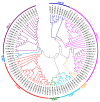ATP-Binding Cassette (ABC) Transporter Genes Involved in Pyrethroid Resistance in the Malaria Vector Anopheles sinensis: Genome-Wide Identification, Characteristics, Phylogenetics, and Expression Profile
- PMID: 30897799
- PMCID: PMC6471920
- DOI: 10.3390/ijms20061409
ATP-Binding Cassette (ABC) Transporter Genes Involved in Pyrethroid Resistance in the Malaria Vector Anopheles sinensis: Genome-Wide Identification, Characteristics, Phylogenetics, and Expression Profile
Abstract
background: The ATP-binding cassette (ABC) transporters family is one of the largest families of membrane proteins existing in all living organisms. Pyrethroid resistance has become the largest unique obstacle for mosquito control worldwide. ABC transporters are thought to be associated with pyrethroid resistance in some agricultural pests, but little information is known for mosquitoes. Herein, we investigated the diversity, location, characteristics, phylogenetics, and evolution of ABC transporter family of genes in the Anopheles sinensis genome, and identified the ABC transporter genes associated with pyrethroid resistance through expression profiles using RNA-seq and qPCR. Results: 61 ABC transporter genes are identified and divided into eight subfamilies (ABCA-H), located on 22 different scaffolds. Phylogenetic and evolution analyses with ABC transporters of A. gambiae, Drosophila melanogaster, and Homo sapiens suggest that the ABCD, ABCG, and ABCH subfamilies are monophyly, and that the ABCC and ABCG subfamilies have experienced a gene duplication event. Both RNA-seq and qPCR analyses show that the AsABCG28 gene is uniquely significantly upregulated gene in all three field pyrethroid-resistant populations (Anhui, Chongqing, and Yunnan provinces) in comparison with a laboratory-susceptible strain from Jiangsu province. The AsABCG28 is significantly upregulated at 12-h and 24-h after deltamethrin exposure in three-day-old female adults. Conclusion: This study provides the information frame for ABC transporter subfamily of genes, and lays an important basis for the better understanding and further research of ABC transporter function in insecticide toxification. The AsABCG28 gene is associated with pyrethroid detoxification, and it functions at later period in the detoxification process for xenobiotics transportation.
Keywords: ATP-Binding Cassette (ABC) transporters; Anopheles sinensis; RNAseq analysis; deltamethrin; gene expression; pyrethroid resistance.
Conflict of interest statement
The authors declare no conflicts of interest.
Figures






Similar articles
-
HSP superfamily of genes in the malaria vector Anopheles sinensis: diversity, phylogenetics and association with pyrethroid resistance.Malar J. 2019 Apr 11;18(1):132. doi: 10.1186/s12936-019-2770-6. Malar J. 2019. PMID: 30975215 Free PMC article.
-
Genome-wide and expression-profiling analyses suggest the main cytochrome P450 genes related to pyrethroid resistance in the malaria vector, Anopheles sinensis (Diptera Culicidae).Pest Manag Sci. 2018 Aug;74(8):1810-1820. doi: 10.1002/ps.4879. Epub 2018 Mar 25. Pest Manag Sci. 2018. PMID: 29393554
-
Identification of carboxylesterase genes associated with pyrethroid resistance in the malaria vector Anopheles sinensis (Diptera: Culicidae).Pest Manag Sci. 2018 Jan;74(1):159-169. doi: 10.1002/ps.4672. Epub 2017 Sep 14. Pest Manag Sci. 2018. PMID: 28731595
-
Identification of the Anopheles gambiae ATP-binding cassette transporter superfamily genes.Mol Cells. 2003 Apr 30;15(2):150-8. Mol Cells. 2003. PMID: 12803476 Review.
-
Insect ATP-Binding Cassette (ABC) Transporters: Roles in Xenobiotic Detoxification and Bt Insecticidal Activity.Int J Mol Sci. 2019 Jun 10;20(11):2829. doi: 10.3390/ijms20112829. Int J Mol Sci. 2019. PMID: 31185645 Free PMC article. Review.
Cited by
-
Identification and Expression Characterization of ATP-Binding Cassette (ABC) Transporter Genes in Melon Fly.Insects. 2021 Mar 23;12(3):270. doi: 10.3390/insects12030270. Insects. 2021. PMID: 33806814 Free PMC article.
-
The Transcriptomic Response of the Boll Weevil, Anthonomus grandis grandis Boheman (Coleoptera: Curculionidae), following Exposure to the Organophosphate Insecticide Malathion.Insects. 2023 Feb 16;14(2):197. doi: 10.3390/insects14020197. Insects. 2023. PMID: 36835767 Free PMC article.
-
Prognostic significance and molecular mechanisms of adenosine triphosphate-binding cassette subfamily C members in gastric cancer.Medicine (Baltimore). 2019 Dec;98(50):e18347. doi: 10.1097/MD.0000000000018347. Medicine (Baltimore). 2019. PMID: 31852133 Free PMC article.
-
In Vitro and In Vivo Validation of CYP6A14 and CYP6N6 Participation in Deltamethrin Metabolic Resistance in Aedes albopictus.Am J Trop Med Hyg. 2023 Feb 6;108(3):609-618. doi: 10.4269/ajtmh.22-0524. Print 2023 Mar 1. Am J Trop Med Hyg. 2023. PMID: 36746656 Free PMC article.
-
High-Resolution Genetic Mapping Combined with Transcriptome Profiling Reveals That Both Target-Site Resistance and Increased Detoxification Confer Resistance to the Pyrethroid Bifenthrin in the Spider Mite Tetranychus urticae.Biology (Basel). 2022 Nov 7;11(11):1630. doi: 10.3390/biology11111630. Biology (Basel). 2022. PMID: 36358331 Free PMC article.
References
MeSH terms
Substances
Grants and funding
LinkOut - more resources
Full Text Sources
Molecular Biology Databases

